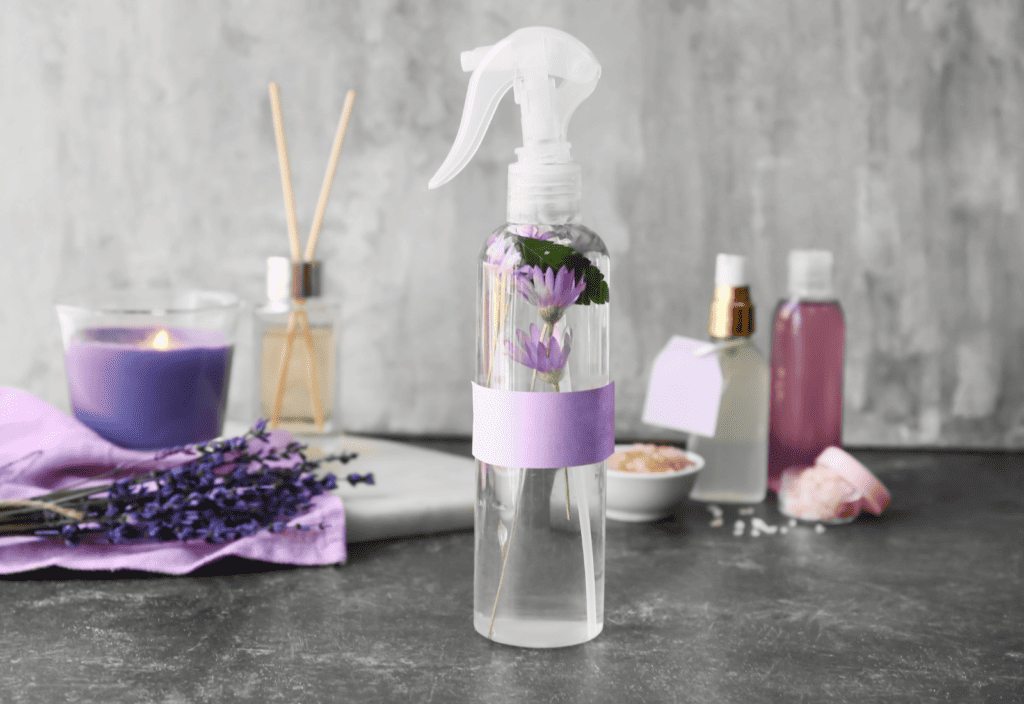A key component of health that is often overlooked in our healthcare system is exposure to toxins with the exception of a really well-known few like tobacco and asbestos. If you want to protect your long-term health while also weeding out little ailments including allergies, fatigue and headaches, it’s worthwhile to learn how to reduce toxins in your home.

This post contains affiliate links. At no extra cost to you, I may earn a small commission on qualifying purchases.
My husband and I got into clean living nearly 13 years ago. We’ve experienced many benefits, but one that really stands out to me is that I rarely get a headache. If I get a headache these days, it’s almost always when I go into a place with strong smells, usually artificial.
In the past, I remember having frequent headaches. I carried around Ibuprofen in my purse like many women do. I thought little headaches were just a part of life, but they don’t have to be. Headaches are often caused by something you eat or something present in your environment.
Beyond the simple pleasures of rare headaches, avoiding toxins can reduce your disease and cancer risk. Often it takes decades for researchers to make a link between a toxin and disease.
Even after a connection is made, it can take additional years to get a product off the market. Think talcum powder, asbestos, brominated tris (a flame retardant once added to children’s pajamas) or Glyphosate (Round Up).
Toxins in the home is a broad topic. If you are building or renovating, for example, you will want to think about the materials used for flooring, wall paint, insulation and fixtures.
While it’s impossible to cover each and every toxin in one blog post, let’s dive into how to reduce toxins in your home without having to completely gut your house.
Reduce Toxins in Your Water
Clean water is up there on the priority list, since we drink all day, every day. The cheapest way to ensure clean water is by installing a kitchen counter filter … the best you can afford. A whole house filter is even better if you can swing it. It’s definitely on my wish list!
Our water is cleaned, but the cleaners like chlorine stick around in your water as well as a whole host of other things (lead, pharmaceuticals, pesticides, etc.). Another concern is the type, age and condition of your pipes.
Even relatively new pipes may contain trace amounts of lead and other heavy metals. Plastic pipes contain contaminants also. According to the EWG, Environmental Working Group, copper or polyethylene pipes are the safest bets, but that information is only helpful if you are building or renovating your home.
To find out what is in your tap water, check out the EWG Tap Water Database. Simply type in your zip code, and you can see which contaminants are in your tap water and where they fall on the EWG recommended limit. The EWG limit is stricter than the federal limit.

I live in a rather affluent area, but there were still nine toxins identified and four were over the EWG recommended limit. All with a side effect of cancer—nice! The resource tells you what type of filter will filter out the contaminants lurking in your water.
For the contaminants in my area, a reverse osmosis filter will do the best job. After you check out the resource, be sure to email the utility company as well as your elected officials. Everyone deserves clean water, even those who don’t have water filters.
Avoid Flame Retardants in Your Home
Flame retardants are found in things like upholstered furniture, carpet, camping gear and car seats. They are linked to several undesirable conditions such as endocrine and thyroid disruption, immune system dysfunction, reproductive toxicity, cancer, birth defects and neurologic function.
Flame retardants became a thing in the 1970s when smoking in homes was common and fire detectors weren’t regulated. The idea was that the house won’t catch on fire quite as quickly if everything is doused in flame retardants. With fewer people smoking indoors, smoke detectors required in each bedroom flame retardants are much less necessary.
We also now know that flame retardants are toxic, so it’s best to minimize their use as much as possible. There are many different types of flame retardants some of which are more troublesome than others.
The U.S. allows more flame retardants than the EU for example. The EU tends to regulate toxins much more strictly than the U.S. all around. If you see any product is using EU safety standards, that is a good sign.
Flame Retardants in Furniture
Some stores that regularly offer flame-retardant free furniture like sofas, chairs, and rugs are IKEA, Pottery Barn, West Elm, Crate and Barrell and Medley Home. Amazon carries rugs by Safavieh—they offer cotton and wool fabric options and do not use added flame retardants. Hook and Loom, which is a minimalist style, is another option for rugs.
Flame Retardants in Mattresses
For mattresses, we personally use My Green Mattress as they are the most budget friendly. Other non-toxic mattress options are Avocado Green Mattress and Naturepedic. If you want to focus on just one thing at a time, I vote that you start with mattresses. We spend more time in close contact with our mattress than anything else. The main sofa in the home would be next on my list.
It’s difficult and even impossible to completely avoid flame retardants. Car seats are an example of this. The Britax brand uses EU standards (generally stricter and safer than US standards). Camping gear is another tricky one. We are not avid campers, but there are some tents and air mattresses without added flame retardants.
Skip the Pesticides and Herbicides
The dangers of pesticides are well documented … think Round Up weed killer lawsuits. We know without a doubt that pesticides are dangerous to living creatures, including humans. Pesticide is a broad category that includes insecticides, herbicides, fungicides and rodenticides.

It wasn’t until I had children that I started to really research the dangers of pesticides. One of the first studies I always share is the Harvard study that suggests indoor pesticides increase cancer and brain tumor rates in children. As a parent, there isn’t much scarier than the thought of childhood cancer.
Thankfully, there are many green and IPM (Integrated Pest Management) pest control companies these days. Be sure to ask lots of questions as some companies aren’t quite as green as they claim to be. The DIY route is my favorite now that I have a little practice.
You can read about my strategy in 7 Tips for Natural Pest Management, which has worked for us for the past decade (5 of those years in a rural setting). So much can be controlled simply by keeping a tidy home and yard, using glue boards (total game changer) and natural insect repellents as necessary.
Discover Less Toxic Paint/Finishes
When we think of VOCs (volatile organic compounds), we often think of paint, but VOCS are essentially just toxins that are emitted into the air. They can come from a number of sources. If you are painting walls, choose zero-VOC paint, which is fairly common these days.
Wood furniture often comes coated in heavy metals. Toxins such as lead, arsenic, beryllium, chromium, cadmium and nickel are used as drying agents. Furniture also often contains MDF (medium density fiberboard), which contains formaldehyde (another VOC). If you’re furniture was affordable it likely contains MDF.
You can avoid many of these toxins by looking for furniture with the Green Guard Label, which ensures low emissions of VOCs into the air. Buying unfinished or used furniture (that has off gassed) and painting it with non-toxic chalk paint is another option.
Stores that frequently carry Green Guard Label furniture are IKEA, Pottery Barn, West Elm, Crate and Barrell and Medley Home. As you can guess, the Green Guard label will cost you. Because of this, I typically go with second-hand furniture that has already off gassed.
Off gassing varies, of course, but even buying year-old furniture will dramatically reduce the VOCs being released into your home. If you just have to have something, and it’s not Green Guard or second hand, you can always leave it in the garage a few weeks or months (if you’re willing to wait that long).
If painting is in your near future, see my related post on zero VOC paint.
Say Goodbye to Artificial Fragrances
Products that often contain synthetic fragrance are candles, perfume, self-care products, cleaning products and laundry detergent.

Synthetic fragrance is another word for artificial fragrance. It’s the process of combining various chemicals to create a vanilla smell without needing actual vanilla. It’s cheaper to create scents using synthetic fragrance than to source natural fragrances from the plants and herbs themselves.
The term “fragrance” or ‘parfum” on a product label, can represent a combination of thousands of ingredients that are used to make a specific scent. These mystery ingredients, which manufactures are not required to reveal, are often derived from petroleum/crude oil.
Synthetic fragrance can include benzene derivatives (a known carcinogen), toluene, aldehydes and other toxins linked to allergies, birth defects, central nervous system disorders and even cancer. Some of these ingredients are endocrine disruptors affecting hormonal health, which can lead to countless issues from diabetes and respiratory issues to infertility.
Fragrance is one of the cheapest and easiest things on this list to cut out, and I can almost guarantee you will have fewer headaches if you do. There are tons of high-quality, safe alternatives for most of your favorite things that are fragrance free or naturally scented.
See my post on The Dangers of Synthetic Fragrance to learn how to avoid synthetic fragrances and discover some brands you can trust to never use them.
Switch to Less Toxic Cleaning Products
Traditional cleaning products are filled with toxins and questionable ingredients. For example, the main ingredient in Lysol Disinfecting Wipes is Alkyl Dimethyl Benzyl Ammonium Chlorides (C12-16), which scores a D (formerly an F) from the Environmental Working Group (EWG). Wipes like these also contain Myristalkonium Saccharinate, which scores a D from the EWG.
Cleaning products also frequently contain synthetic fragrance, which we just covered above.
You may have seen the study a few years ago that compared the lung damage of cleaning to that of smoking. That’s right, frequent household cleaning with traditional products damaged lungs as much as smoking a pack a day! If that’s not a reason to clean up your cleaning routine, I don’t know what is.
When we clean, we inhale the fumes. That’s why it’s recommended to clean in well ventilated areas and open windows and doors when possible. Many cleaners are also toxic when they come in contact with skin, which is why labels recommend using gloves when cleaning.

I am a baking soda and vinegar girl myself, but thankfully there are many safe options for cleaning like Norwex (yes, a microplastic so not perfect), homemade vinegar sprays and baking soda pastes. Not to mention, there are countless eco-friendly product lines to choose from.
How to Reduce Toxins in an Older Home?
If you live in an older home, there is always the possibility of lead paint in the home. Lead paint was used until 1978 so many of us grew up in homes that contained lead paint. There are safe methods to remove and replace lead paint, and if you have young children you want to be hyper vigilant about anywhere there is chipping paint.
As for mold, there are at-home test kits, which can be good for peace of mind. I actually did one a few years ago with an allergy flare up. Signs of mold include musty smells, respiratory symptoms, fatigue. We all have a little mold in our home, so it’s important to keep your home at the right humidity level.
We learned this the hard way when one of our bathroom fans went out, and we didn’t replace it promptly. And spills and small leaks happen. You can’t rip up the floor or tear out the ceiling for every little occurrence.
Simple Measures to Reduce Toxins in the Home
If you are like me and you’ve had a few small leaks and spills and hoped for the best, a good air purifier can be a great precautionary measure. It will help keep minor air contamination in check.
Opening windows and door whenever possible will improve your indoor air quality as will dusting and vacuuming frequently. Toxins settle in the dust of your home, so you want to keep dust to a minimum and keep lots of fresh air coming in.
Conclusion
Thanks for reading about how to reduce toxins in your home! While there are many more areas we could cover, I hope this post offers insight on some of the common and basic changes you can make to reduce the toxic load of your family.
Happy detoxing!